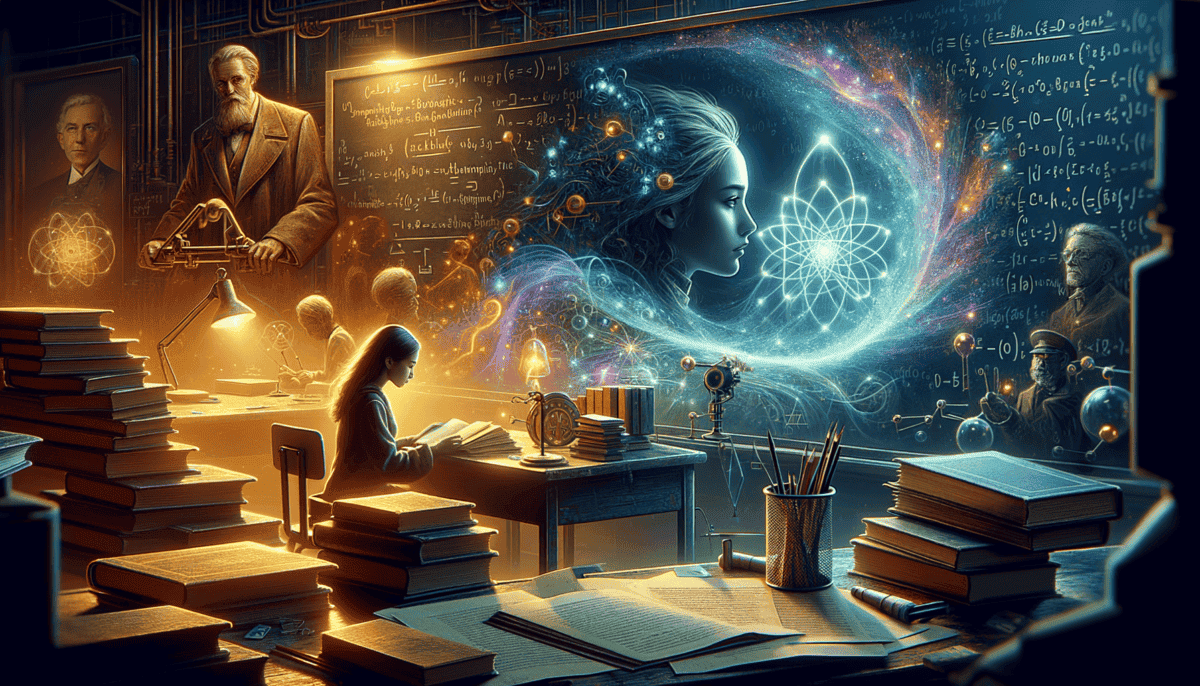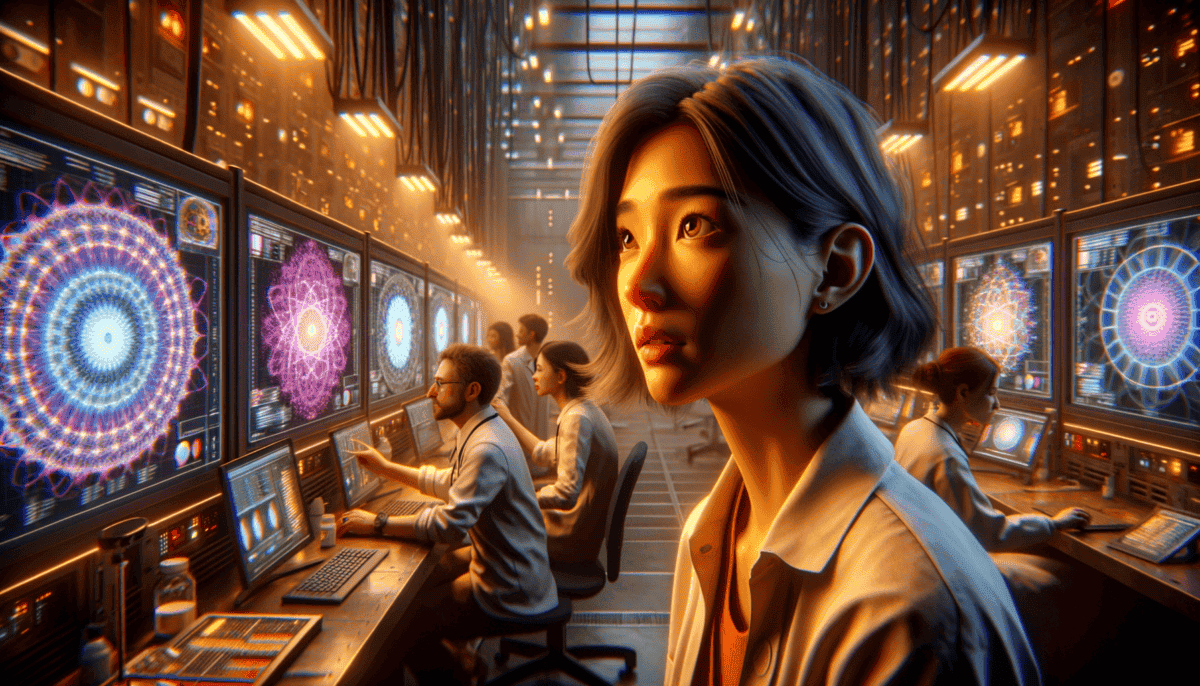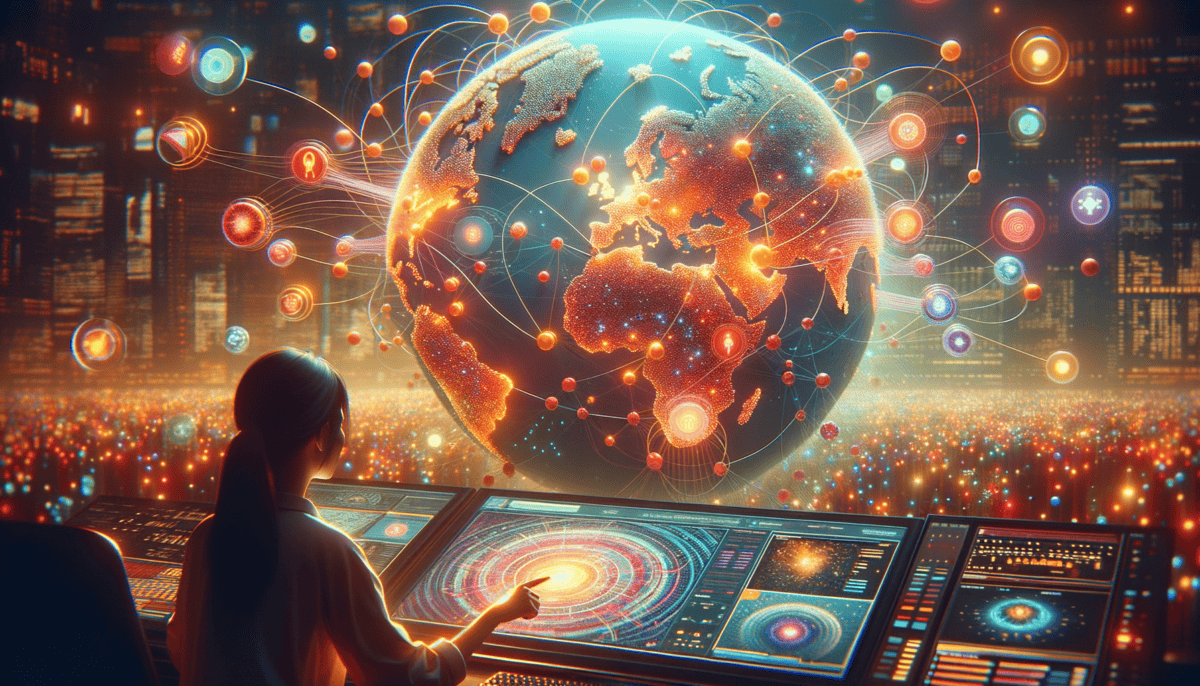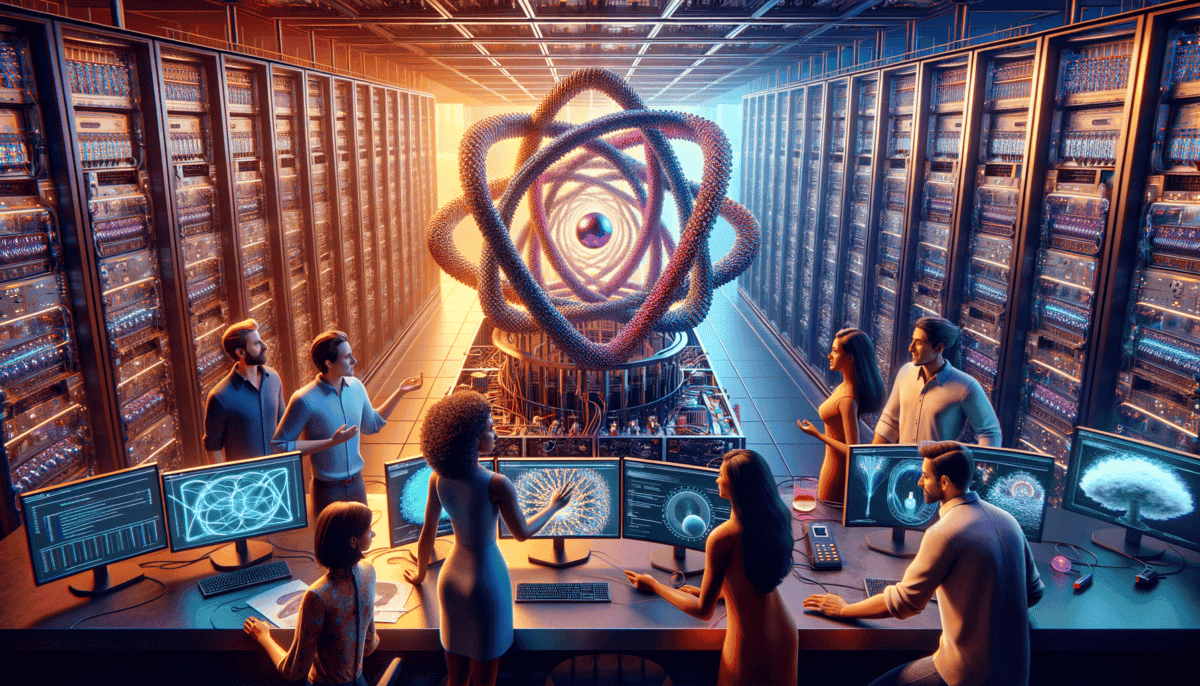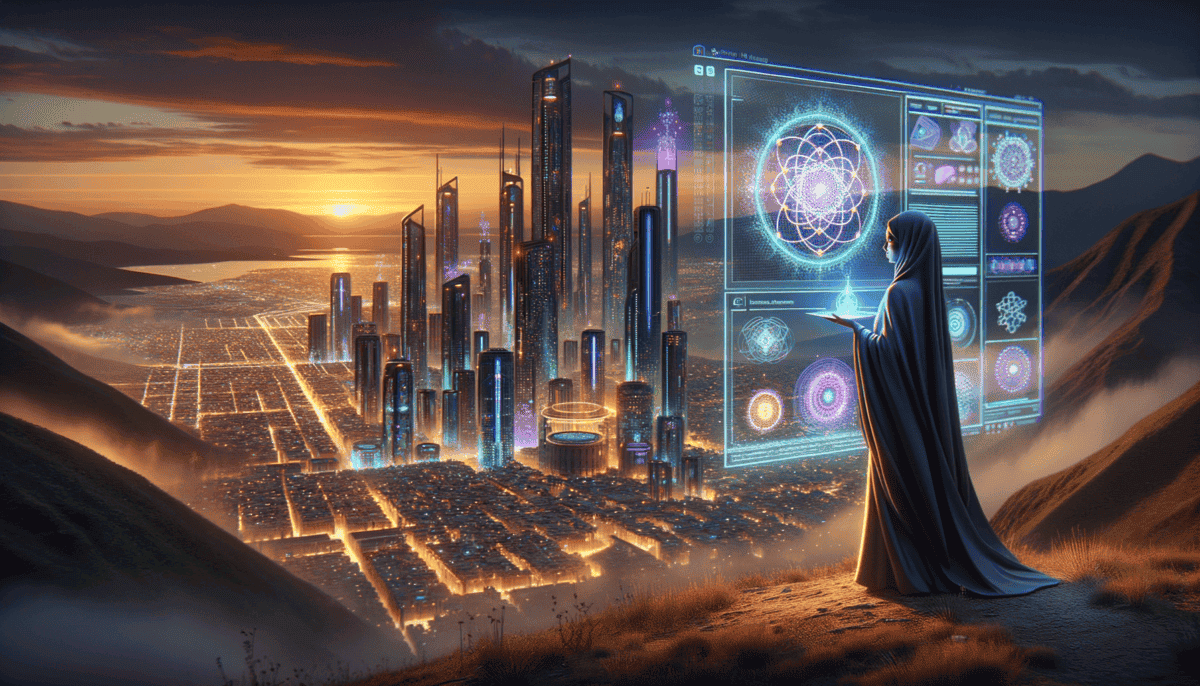The Tiny World of Big Ideas
Maya pressed her face against the microscope in her school's science lab, her dark curls falling around her shoulders. The tiny particles she saw dancing under the lens made her brown eyes grow wide with wonder.
"What makes them move like that?" she whispered to herself.
Mr. Rodriguez, her science teacher, smiled as he walked over. He had never seen a student so fascinated by particle behavior before.
"Those tiny things you're watching follow special rules," he explained. "Rules that are different from the big things we can see."
Maya looked up from the microscope. "Different rules? But how?"
"Well," Mr. Rodriguez said, pulling up a chair, "imagine you have a magical coin that can be both heads AND tails at the same time. That's kind of how these tiny particles work!"
Maya's forehead wrinkled in thought. "But that's impossible! A coin has to be one or the other."
"In our normal world, yes," Mr. Rodriguez nodded. "But in the quantum world – the world of very tiny things – the rules are different. These particles can be in many places at once, just like our magical coin!"
Maya's eyes lit up. "Is that why they're so special?"
"Exactly!" Mr. Rodriguez beamed. "And do you know what's even more exciting? Scientists are using these special particles to build super-powerful computers!"
"Better than my mom's laptop?" Maya asked.
"Much better! These quantum computers could solve problems that regular computers would take hundreds of years to figure out."
Maya bounced in her seat. "Can I learn more about them?"
“The quantum world is like a magic show where the impossible becomes possible,” Mr. Rodriguez said with a twinkle in his eye.
That afternoon, Maya rushed home clutching a stack of books about quantum physics from the library. Her mom found her sprawled on the living room floor, surrounded by open books.
"What's all this about?" her mom asked, setting down her work bag.
"Mom! Did you know there are computers that use tiny magical particles? And they can do super hard math problems super fast?" Maya could barely contain her excitement.
Her mom sat down next to her. "Tell me more about these magical particles."
Maya took a deep breath and began explaining everything she had learned. As she talked, her hands moved animatedly through the air, painting pictures of a world where the tiniest things could do the biggest things.
That night, as Maya lay in bed, she couldn't stop thinking about the quantum world. Her dreams were filled with dancing particles and magical coins that could be heads and tails at the same time.
The next morning at breakfast, Maya made an announcement. "I want to work with quantum computers when I grow up."
Her mom smiled. "That's a big dream, sweetie."
"I know," Maya said, determination sparkling in her eyes. "But Mr. Rodriguez says the quantum world makes impossible things possible. So maybe my big dream isn't so impossible after all."
As Maya headed to school that day, she felt different. Yesterday, she had been just another second-grader. Today, she was a future quantum scientist, ready to explore a world where tiny things could make big changes.
She couldn't wait to learn more about this amazing quantum world. And maybe, just maybe, she would help build one of those super-powerful computers herself someday.
The Quantum Pioneers
“Who made the first quantum computer?” Maya asked, bouncing in her chair during science club. It was a week after her amazing discovery about the quantum world.
Mr. Rodriguez pulled out an old photograph. “Let me tell you about some amazing scientists who started it all. This is Richard Feynman.”
Maya leaned forward to look at the smiling man in the black-and-white picture. “He looks fun!”
“He was! Richard loved to solve puzzles and play drums. But he also had a big idea – he thought tiny quantum things could make super powerful computers.”
“Did he build one right away?” Maya asked excitedly.
Mr. Rodriguez shook his head. “Many people didn’t believe it could work. They said it was too hard.”
“But that didn’t stop the quantum pioneers!” piped up Lisa, Maya’s best friend who had joined the science club too.
“You’re right!” Mr. Rodriguez smiled. “Scientists kept trying. They worked together, shared ideas, and never gave up.”
“Sometimes the best ideas seem crazy at first. But that doesn’t mean they’re wrong!” – Richard Feynman
Maya’s eyes sparkled. “Tell us more about the other scientists!”
Mr. Rodriguez showed more pictures. “These brave scientists came from all over the world. They were like explorers, but instead of exploring new lands, they explored the tiny quantum world!”
“Were there any girl scientists?” Lisa asked hopefully.
“Absolutely! Like Dorit Aharonov, who figured out super important math for quantum computers. And today, there are many women working on quantum computers.”
Maya sat up straighter. “Just like I want to do!”
That afternoon, Maya and Lisa decided to make a quantum pioneer project. They drew pictures of the scientists and wrote down their stories.
“Look what I found!” Lisa called out, waving a book. “Some scientists used super cold rooms to make quantum computers work better!”
“How cold?” Maya asked.
“Colder than the North Pole!” Lisa giggled. ❄️
Maya drew little snowflakes around her quantum computer picture. “Why so cold?”
Mr. Rodriguez explained, “The tiny quantum bits need to be very still to work right. Cold helps them stay still, just like how we move slower when we’re cold!”
• Super cold freezer
• Tiny quantum bits
• Smart scientists (that’s us!)
• Lots of patience
At home that evening, Maya told her parents about the quantum pioneers.
“And guess what?” she said between bites of dinner. “They’re still making new discoveries today! We could be quantum pioneers too!”
Her dad smiled. “You already sound like one, talking about quantum computers at dinner!”
That night, Maya dreamed she was working with all the quantum pioneers. In her dream, they built amazing computers that could solve any problem.
The next morning, she drew a picture of herself in a lab coat, standing next to a quantum computer. She wrote underneath: “Maya the Quantum Pioneer.”
“Can I put this on the science club wall?” she asked Mr. Rodriguez.
“Of course! And maybe someday, students will learn about you as one of the quantum pioneers!”
Maya beamed. She couldn’t wait to join the amazing group of scientists who dared to dream big about tiny quantum things.
“Just like Richard Feynman,” she thought, “I won’t give up, even if people say it’s too hard!”
Breaking the Binary Barrier
Maya rushed into the science lab, her eyes wide with excitement. Today was special – her class would help test a real quantum computer! ️
“Welcome to Quantum Labs!” Dr. Sarah Chen smiled warmly. She wore a shiny lab coat with little atom symbols on it.
“What makes quantum computers different from regular ones?” Maya asked.
“Let me show you something fun,” Dr. Chen said. She held up two spinning tops. “See how they spin?”
The class gathered around, watching the tops twirl and wobble.
“Regular computer bits are like tops that can only point up or down,” she explained. “But qubits are like spinning tops – they can point many ways at once!”
“Wow!” Lisa whispered. “That’s like magic!” ✨
“It’s quantum magic!” Maya giggled.
Dr. Chen led them to a big machine that looked like a shiny metal cabinet. “This is our quantum computer. Want to see inside?”
“The hardest part is keeping the qubits happy. They’re very shy – they don’t like noise or heat!”
The machine had lots of wires and a special cooling system that made soft humming sounds. Maya could feel the cold air around it.
“Can we try to solve a problem?” Maya asked hopefully.
“Let’s do it!” Dr. Chen typed on her computer. “We’re going to ask the quantum computer to find the best way to deliver packages to different houses.”
The regular computer tried first. It took a long time and made buzzing noises.
Then the quantum computer tried. *ZING!* It found the answer super fast!
“That’s amazing!” Maya clapped. “How did it do that?”
“The quantum computer tried all the paths at the same time,” Dr. Chen explained. “Like having a million helpful friends working together!”
But then something went wrong. The quantum computer started making strange noises.
“Oh no!” Dr. Chen frowned. “The qubits are getting too warm.”
Maya remembered what she learned about the quantum pioneers. “We need to make it colder!”
Dr. Chen smiled. “You’re right! Watch this.” She pressed some buttons, and cold mist swirled around the machine. The noise stopped.
“You just helped fix a quantum computer!” Dr. Chen high-fived Maya. “Want to join our junior research team?”
Maya’s heart jumped with joy. “Yes, please!”
Back in science club, Maya couldn’t stop talking about her quantum adventure.
“And guess what?” she told her friends. “Dr. Chen says they’re making new kinds of qubits that work better! Maybe we’ll help build them!”
Mr. Rodriguez looked proud. “You’re already breaking barriers, Maya. Just like the quantum pioneers we learned about.”
That evening, Maya added to her science journal:
“Today I learned that quantum computers are like having a million helpers solving puzzles at once. And I’m going to help make them even better!”
She drew a picture of herself in her future lab, working with happy qubits that sparkled like stars. The quantum adventure was just beginning! ⭐
The Global Race
Maya sat in her new spot at Quantum Labs, watching a video call with scientists from all around the world.
“Welcome to the International Quantum Conference!” Dr. Chen waved at the screen. Friendly faces from Japan, Germany, China, and India smiled back.
“Look at this!” Maya pointed excitedly. “Everyone’s working on quantum computers!”
Dr. Tanaka from Japan showed pictures of their shiny new lab. “Our quantum computer uses light to make qubits!”
“That’s so cool!” Maya’s eyes sparkled. “We use super cold atoms for our qubits.”
Dr. Schmidt from Germany spoke next. “We just made a quantum computer that can dance with 50 qubits at once!”
“Every country has special tricks to make their quantum computers work better. It’s like having different recipes for cake – they’re all yummy!”
During lunch break, Maya drew a world map in her notebook, putting little stars where quantum labs were working. ⭐
“Why is everyone trying so hard?” she asked Dr. Chen.
“Because quantum computers can help solve big problems,” Dr. Chen explained. “Like finding new medicines or helping planes fly better!”
Suddenly, alarms started beeping in their lab. The quantum computer was acting funny again!
“Quick!” Maya remembered her training. “Check the temperature!”
But it wasn’t too hot this time. Something else was wrong.
Dr. Chen looked worried. “The qubits aren’t dancing together right. They’re getting confused.”
“I have an idea!” Maya grabbed her tablet. “Can we ask our friends in other countries for help?”
Dr. Chen smiled big. “That’s brilliant!”
They called their quantum friends around the world. Dr. Tanaka suggested checking the laser settings. Dr. Schmidt had a special code to fix mixed-up qubits.
Working together, they fixed the problem! The quantum computer hummed happily again.
Later that day, Maya made a special presentation for her science club:
“Quantum computers are like a big puzzle, and scientists everywhere are sharing pieces to solve it together!”
Mr. Rodriguez clapped. “That’s what makes science amazing – we all help each other!”
That night, Maya updated her quantum diary with tiny flag stickers:
“Today I learned that the best way to win the quantum race is to work together. Every country has good ideas!”
She drew herself in a cape, flying around the world to visit quantum labs. Next to it, she wrote: “Future Quantum Explorer!”
The next morning, Dr. Chen had big news. “Maya, want to join a special project with kids from other countries?”
Maya jumped up and down. “Yes! What are we going to make?”
“Something that might change the world,” Dr. Chen winked. “But first, we need to solve an even bigger puzzle…”
Solving the Unsolvable
Maya bounced into the lab one morning, her eyes wide with wonder. Today was special – they were going to try something amazing with their quantum computer!
“Look at this, Maya!” Dr. Chen pointed to a screen full of colorful patterns. “Our quantum computer is ready to solve a super hard puzzle.”
“What kind of puzzle?” Maya asked, pulling up her special lab chair.
“We’re going to help doctors find new medicine,” Dr. Chen smiled. “Our quantum friend here can look at millions of tiny molecules at once!”
Maya watched as the quantum computer started working. Its qubits danced faster than ever before.
“It’s like having a million helpers all working together at the same time!”
“But wait!” Maya pointed at a flashing light. “Something’s happening!”
The computer had found something – a new way to make medicine that could help sick people feel better!
“This is just the beginning,” Dr. Chen grinned. “Want to see what else we can do?”
They spent the day trying different problems:
• Finding better ways to grow food
• Making cars that don’t hurt the Earth
• Helping airplanes use less fuel
• Making stronger buildings
“But Maya,” Dr. Chen said seriously, “with great power comes great responsibility.”
“Like Spider-Man?” Maya giggled.
“Exactly! We need to be careful how we use quantum computers. They’re very powerful.”
Maya thought about this while drawing in her science notebook. She drew a quantum computer wearing a superhero cape. ♀️
“Dear Diary, Today I learned that quantum computers are like magic helpers. But we have to use them wisely!”
Later that afternoon, Maya’s class visited the lab. Her friends couldn’t believe their eyes!
“Can it really solve any problem?” Tommy asked.
“Not any problem,” Maya explained. “But it can help with lots of big ones. Like finding ways to clean our oceans!”
Ms. Johnson, their teacher, looked impressed. “Maya, you’ve learned so much!”
That evening, Maya had a special video call with quantum kids from other countries. They shared their own discoveries:
“Our quantum computer helped predict weather better!” said Yuki from Japan.
“Ours is learning to protect important secrets!” added Luis from Brazil.
Maya felt proud to be part of this global quantum team. She raised her hand with an idea.
“What if we all work together on the biggest problem ever?”
Dr. Chen leaned forward. “What problem is that, Maya?”
“Helping our planet stay healthy!” Maya drew a picture of Earth with a big heart around it.
The other kids loved her idea. Soon, they were all planning their next big project together.
Before going home, Maya wrote one more note in her diary:
“Sometimes the biggest problems need the tiniest helpers – like quantum bits! And when we work together, nothing is unsolvable!”
As she packed up her backpack, Dr. Chen called out, “Maya! Wait until you see what we’re doing tomorrow…”
The Quantum Future
The sun rose on a very special day. Maya stood in front of a huge crowd at the World Science Fair. Her quantum computer project was the star of the show! ⭐
“Ladies and gentlemen,” Maya spoke into the microphone, “let me show you what the future looks like!”
“Our quantum friend here,” Maya patted the shiny machine, “can figure out how to make clean energy for everyone on Earth!”
Dr. Chen stood nearby, beaming with pride. “Show them what it can do, Maya!”
Maya pressed a big green button. The quantum computer hummed to life, its lights twinkling like stars.
“Watch as it designs solar panels that work even on cloudy days!”
The crowd gasped as 3D images appeared, showing new ways to power cities without hurting nature.
Maya’s friends from around the world joined through video chat:
“In Japan, we’re using quantum computers to make better electric cars!” said Yuki.
“In Brazil, we’re helping save the rainforest!” added Luis.
Dr. Chen stepped forward. “But the best part is what Maya discovered last week.”
• Flying cars that don’t need fuel
• Houses that clean the air
• Robots that help clean oceans
• Space ships that can travel super far
Maya’s little sister Emma raised her hand. “Can I be a quantum scientist too?”
“Of course!” Maya smiled. “The quantum future needs everyone’s help!”
That afternoon, Maya and her friends set up a special classroom. They called it the “Quantum Kids Club.”
“Today, we’re going to learn how quantum computers can talk to each other across space!”
Emma and her friends watched in wonder as Maya showed them quantum teleportation.
“It’s like magic!” Emma clapped.
“Not magic,” Maya winked. “It’s science! And someday, you might discover something even cooler!”
As the sun set, Maya looked at her quantum computer one last time. Its lights seemed to twinkle back at her.
“The future is quantum bright,” she whispered. “And we’re just getting started!”
Maya opened her diary and wrote her final entry:
“Dear Diary, Today I learned that quantum computers aren’t just machines – they’re keys to unlock a better tomorrow. And the best part? Anyone can help turn these quantum dreams into reality!”
Outside the lab, a new sign went up: “Quantum Explorers Welcome!” And below it, in Maya’s handwriting: “The future is waiting for YOU!”
That night, Maya dreamed of quantum computers dancing with stars, solving problems big and small, making the world a little better, one qubit at a time.
As she drifted off to sleep, she smiled, knowing that somewhere out there, another young scientist was about to begin their own quantum adventure…


